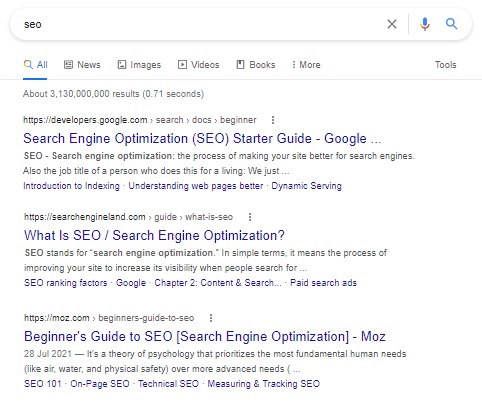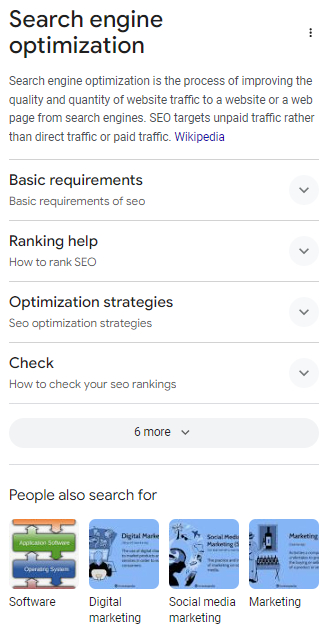
This blog post was updated on 5 May 2024.
With the development of AI, the use of entities and Google better understanding what users are searching for, context has become the central focus of on-page SEO.
Before optimising any of your website content, you should first understand the context and the user intent behind the search query you want to target.

The good news is that, to do so, you will not need any tool in particular. You can just have a look at the search results page. By looking at the layout of the search results page, and the top performing pages, you can identify the user intent and the context of your search term.
In addition, search engine results page (SERP) features can help you identify different types of content and resources to include on your page. For example, if there are video snippets in the SERP, you might want to add video content to your page.
Let’s look at an example. If we look up the search term “SEO” in Google, based on the top performing pages we can clearly identify the informational user intent. The top performing search results are pages featuring content about what SEO is and the basic concepts of SEO, which means that the users looking for this query are at the very first stage of the user journey.

For many search queries, there will be “people also ask” box features in the search results. These reflect the most commonly asked questions related to a particular search query, and thus, can be very helpful when it comes to content creation.
In our example, the “people also ask” box reflects questions such as “what SEO means”, “what is SEO and how it works” and “how do I SEO my website” (sic). These are some of the commonly asked questions in regards to the search term “SEO” and should certainly be considered when creating the content.

In our example, there is also a knowledge graph in the SERP. Entities are the basis of knowledge graphs and Google’s knowledge base. Thus, these SERP elements can offer insightful information on different concepts (topics) related to the search term you are optimising your content for.
By including these different concepts, related to the main topic, in your content, you will make it easier for Google to understand what your page is about, by recognising related topics and their interdependencies.
This is what the knowledge graph looks like in our “SEO” example:

Knowledge graphs tend to “steal” clicks from the websites, as any user that only wants to know what SEO is will not even have to click to any of the search results to get this answer. On the other hand, the users who do decide to visit a certain page from the SERP will certainly expect to get more information on this topic, thus you should ensure the relevant content is provided to them.
To identify what this information is, you can use different SERP features, such as “people also ask” boxes, knowledge panels and top performing pages. These elements will help you identify the context of your search terms, and are also useful when it comes to structuring and writing your content.
Want to learn more?
I hope this blog post has been a useful introduction to the topic of on-page SEO, particularly how to understand context and user intent. For more in-depth information and advice, read my full-length guide here! From reading this guide, you will learn about:
- helpful content systems and people-first content
- the E-E-A-T framework for high-quality content
- the importance of understanding search intent and user needs
- how to harness the power of entities
- how to optimise your content step-by-step







